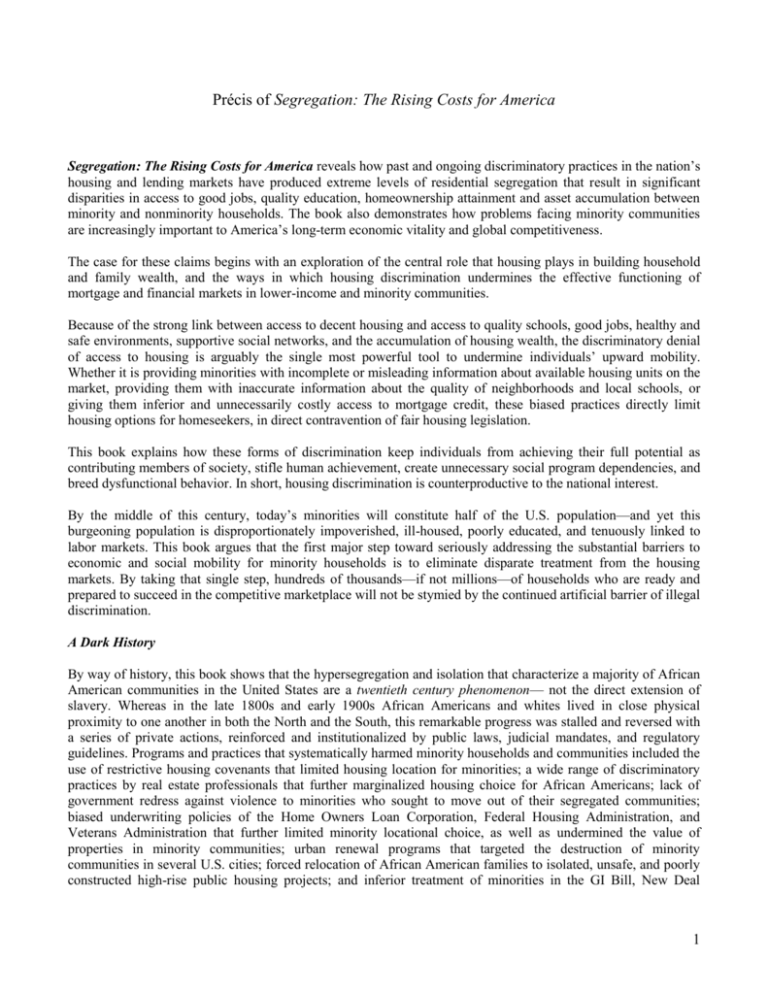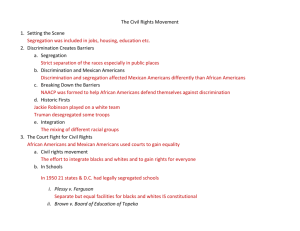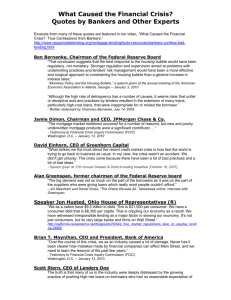Segregation - National Fair Housing Alliance
advertisement

Précis of Segregation: The Rising Costs for America Segregation: The Rising Costs for America reveals how past and ongoing discriminatory practices in the nation’s housing and lending markets have produced extreme levels of residential segregation that result in significant disparities in access to good jobs, quality education, homeownership attainment and asset accumulation between minority and nonminority households. The book also demonstrates how problems facing minority communities are increasingly important to America’s long-term economic vitality and global competitiveness. The case for these claims begins with an exploration of the central role that housing plays in building household and family wealth, and the ways in which housing discrimination undermines the effective functioning of mortgage and financial markets in lower-income and minority communities. Because of the strong link between access to decent housing and access to quality schools, good jobs, healthy and safe environments, supportive social networks, and the accumulation of housing wealth, the discriminatory denial of access to housing is arguably the single most powerful tool to undermine individuals’ upward mobility. Whether it is providing minorities with incomplete or misleading information about available housing units on the market, providing them with inaccurate information about the quality of neighborhoods and local schools, or giving them inferior and unnecessarily costly access to mortgage credit, these biased practices directly limit housing options for homeseekers, in direct contravention of fair housing legislation. This book explains how these forms of discrimination keep individuals from achieving their full potential as contributing members of society, stifle human achievement, create unnecessary social program dependencies, and breed dysfunctional behavior. In short, housing discrimination is counterproductive to the national interest. By the middle of this century, today’s minorities will constitute half of the U.S. population—and yet this burgeoning population is disproportionately impoverished, ill-housed, poorly educated, and tenuously linked to labor markets. This book argues that the first major step toward seriously addressing the substantial barriers to economic and social mobility for minority households is to eliminate disparate treatment from the housing markets. By taking that single step, hundreds of thousands—if not millions—of households who are ready and prepared to succeed in the competitive marketplace will not be stymied by the continued artificial barrier of illegal discrimination. A Dark History By way of history, this book shows that the hypersegregation and isolation that characterize a majority of African American communities in the United States are a twentieth century phenomenon— not the direct extension of slavery. Whereas in the late 1800s and early 1900s African Americans and whites lived in close physical proximity to one another in both the North and the South, this remarkable progress was stalled and reversed with a series of private actions, reinforced and institutionalized by public laws, judicial mandates, and regulatory guidelines. Programs and practices that systematically harmed minority households and communities included the use of restrictive housing covenants that limited housing location for minorities; a wide range of discriminatory practices by real estate professionals that further marginalized housing choice for African Americans; lack of government redress against violence to minorities who sought to move out of their segregated communities; biased underwriting policies of the Home Owners Loan Corporation, Federal Housing Administration, and Veterans Administration that further limited minority locational choice, as well as undermined the value of properties in minority communities; urban renewal programs that targeted the destruction of minority communities in several U.S. cities; forced relocation of African American families to isolated, unsafe, and poorly constructed high-rise public housing projects; and inferior treatment of minorities in the GI Bill, New Deal 1 programs, and other public housing assistance efforts. These policies and practices related to housing and other economic areas, as well as the general national climate in which these policies and practices thrived, explain much of the present state of disadvantage faced by millions of American families. Collectively, these programs had the impact of denying African Americans access to quality housing in growing and vibrant communities with proximity to quality public educational institutions and jobs. This reality greatly undermined the accumulation of black wealth, in the form of housing assets, as well as denying blacks access to broader societal opportunities. Upon this historical background, a central thesis of this book is that discrimination continues to persist at high levels, thus ensuring that the legacy of past discriminatory practices will not easily fade as mere relics of the past. A main cause of these persistent social barriers is the nation’s failure to enforce existing fair housing and lending laws. Such enforcement is woefully underfunded and low on the public policy priority agenda. For example, although the Fair Housing Act was passed in 1968, the U.S. Department of Justice did not prosecute a major case against a mortgage lending institution until the early 1990s—the case against Decatur Federal S&L. Case Study: Subprime Lending As is by now widely known, subprime lending has grown rapidly since the early 1990s. In 2005, annual subprime loan originations were worth $625 billion, a fivefold increase since 2001 and a thirteen-fold increase since 1994. By 2006 the subprime share of total mortgage originations had reached 23 percent. And with the proliferation of subprime lending came the great increase in predatory practices in mortgage lending, especially within minority communities. Thanks to the combination of easier availability of mortgage credit and the excessively high costs of many subprime loans, the good news of rising homeownership rates among minority families in the 1990s was dampened by the increasing share of minority homeowners who pay more than half their income for housing, thereby elevating the risks of foreclosure. In the nation’s largest twenty-five cities, over the 1990s the number of African American homeowners increased by 16 percent, but the number of African American homeowners who paid more than half their income for housing grew by 39 percent. The net result of the excessive use of predatory, high-cost lending in minority communities is clear: the nation is in the middle of one of the most significant foreclosure crises in history. The Center for Responsible Lending estimates that 2 million American families with subprime mortgages are currently at risk of losing their homes to foreclosure, at a cost of as much as $164 billion. Because of the disproportionate impact of predatory lending on African American households, we are now seeing black homeownership fall rapidly. Indeed, over the last three years, the decline in homeownership among African Americans has destroyed almost half the gains made in the decade from 1994 to 2004. And yet fair lending enforcement has remained mired in ambiguity and inaction. There have been virtually no court decisions in cases related to home mortgage lending discrimination, and federal enforcement agencies such as the Office of the Comptroller of the Currency (OCC) and the Federal Reserve Board have been reluctant to investigate cases of disparate impact discrimination, despite clear guidance from the Federal Financial Institutions Examination Council (FFIEC) that establishing disparate impact discrimination is a method of proving lending discrimination. A Brief Look at Other Topics Covered Recent Trends in American Segregation: By some measures, segregation has declined in recent decades. But where segregation has declined, it has generally been in relatively small Sunbelt communities with small African American populations. Also, in many areas of the country where segregation has declined, it can be attributed to increased exposure of blacks to Latinos. In older Northeastern and Midwestern industrial communities, traditional levels of black-white segregation persist. 2 Income and Wealth Disparities: Housing is the foremost source of wealth creation for the typical American family. Substantially lower homeownership rates for African American and Latino households, due directly to discriminatory actions of the past that continue today, translate into severe wealth disparities by race/ethnicity in America. While more than 75 percent of non-Hispanic whites own homes, less than 50 percent of African Americans and Latinos are homeowners. Education: Recent studies show that children from lower-income backgrounds are at a disadvantage for educational attainment as well as economic success in life because they are less likely to learn from parents the values, negotiating skills, and language usage that are important for success. Children living in disadvantaged neighborhoods are likely to suffer from poor nutrition, undiagnosed physical and mental challenges, learning difficulties, and a home or neighborhood environment that is not conducive to learning. Access to financial services: Years of discrimination and denial of access to formal avenues of credit have created a bifurcated financial system in the United States. While mainstream financial services are available to middle- and upper-income and nonminority communities, alternative financial services—such as those provided by pawnshops, check cashers, payday lenders, rent-to-own shops, title lenders, and predatory subprime lenders— tend to dominate lower-income and minority communities. Housing and Health: The link between housing and children’s health is best known in the case of lead paint, which has harmful effects on the development of children. Housing location also affects access to physicians, good hospitals, and other healthcare facilities. Stability of housing tenure also reduces stress and stress-related ailments, such as hypertension. Housing and Social Networks: Social networks can promote emotional well-being and a sense of safety, and can also open up a range of important opportunities. Social networks act as social capital. Segregated neighborhoods tend to offer social networks that are likely to be less useful for economic advancement. As this book demonstrates, much of our success as a nation is the result of carefully crafted federal policies that intentionally and directly helped to build the largest and most affluent middle-class society of any nation on earth. Our shortcoming as a nation was that access to those programs and initiatives was not shared equally among all Americans, and the negative results are clear. Compensating for decades of denial of opportunity will not be easy. Because housing is the centerpiece of opportunity in America, this book offers ways to ensure that all Americans have access to the remarkable benefits homeownership can offer. Its primary aim is an enhanced public policy dialogue on the issues and arguments presented in its chapters. Acknowledging and discussing the reality of past and continued housing discrimination, and its negative impacts on families and communities, is the first step toward changing positively the environment for fair housing enforcement. Purging discriminatory housing practices is essential to ensuring that all Americans have the opportunity to achieve their full human potential and value as contributing members of U.S. society. 3







